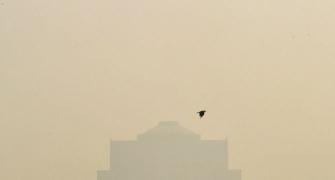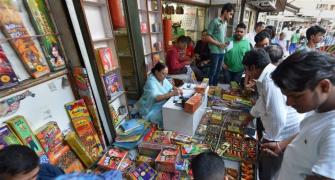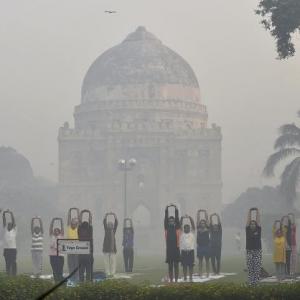
The volume of pollutants markedly came down in Delhi on Saturday with their rapid dispersion caused by a strong wind movement, a day after Diwali fireworks pushed the city's air quality into the 'severe' zone for the first time this year.
The Central Pollution Control Board, which attributed Friday's high pollution levels to calm wind movement and a low mixing height (where air and suspended particles mix), said the situation will improve further by Sunday if favourable conditions prevail.
"The wind speed is expected to pick up and reach up to 9 km/hour, which is adequate enough for the dispersion of suspended particulates. Yesterday and the day before, wind speed and mixing height were extremely low, which led to the rapid build up of pollutants near the surface," Dipankar Saha, CPCB's air lab head, told PTI.
The improvement was captured by the pollution monitoring stations. Six out of the eight stations maintained by SAFAR (System of Air Quality Forecasting and Research), an agency under the ministry of earth sciences, had air quality index in the 'very poor' category, a shade better than 'severe'.
Among the station maintained by the CPCB, nine out of 17 were in the 'very poor' category, while the rest recorded 'severe' air quality.
A 'very poor' AQI comes with the warning that people may develop respiratory illness on prolonged exposure while exposure to 'severe' air affects healthy people and seriously impacts those with existing respiratory or cardiovascular diseases.
At 12 pm, the 24-hour rolling average of PM2.5 and PM10, ultra-fine particulates, which are up to 30 times tinier than the width of a human hair, were 206 and 357 microgrammes per cubic metre (ug/m3) respectively, as against Friday's 407 and 595.
Their 24-hour safe standards are 60 and 100 and anything beyond that is considered harmful as these particles enter the respiratory system and can manage to reach the bloodstream, causing irreparable damage to humans and animals.
Diwali fireworks left Delhi gasping on Friday as night-long bursting of firecrackers despite a Supreme Court ban on their sale had plunged the air quality into the 'severe' zone for the first time this year.
Pollution in Delhi breached emergency levels on the Diwali night and the air quality worsened the day after, but compared to last year's post Diwali period, the city is relatively better off, the pollution monitoring agencies concurred in their reports.
The CPCB, the country's apex pollution regulator, had on Friday recorded an air quality index of 403 in Delhi, 402 in Noida and 412 in Ghaziabad, all in the severe zone, or the most polluted category, on October 20.
In a direct indicator of the impact of firecrackers, the SO2 (sulphur dioxide) levels that otherwise remain very low in the region, had increased by more than three times in several locations, including R K Puram, Shadipur and Punjabi Bagh on October 19, the Centre for the Science and Environment said.
Delhi Environment Minister Imran Hussain had reviewed the situation during a meeting on Friday. The government had issued a statement following the meeting, saying major changes in the level of pollutants were observed after 8 pm on Thursday when the fireworks started.
On Friday, the United States Embassy's pollution monitor recorded 'hazardous' air quality with the index scoring an alarming 878, which the mission considers "beyond its air quality index", which ends at 500".
But unlike previous years, the run-up to Diwali festivities was much cleaner this time.
Even the Diwali evening was relatively quiet and promising, suggesting that the ban on sale of firecrackers in the Delhi-NCR region imposed by the apex court has worked.
As the clock ticked, frenzied celebrations picked up and noisy and relentless bursting of firecrackers continued till the wee hours, sending the pollution graph off the charts.
The Supreme Court-appointed Environment Pollution Prevention and Control Authority, which is empowered to enforce the Graded Response Action Plan to combat air pollution in Delhi-NCR, kicked off a series of preventive measures on October 17.
Measures under the GRAP's 'very poor' and 'severe' categories, which include a ban on diesel generator sets, have come into effect and will remain in force till March 15.
Photograph: Vijay Verma/PTI Photo










